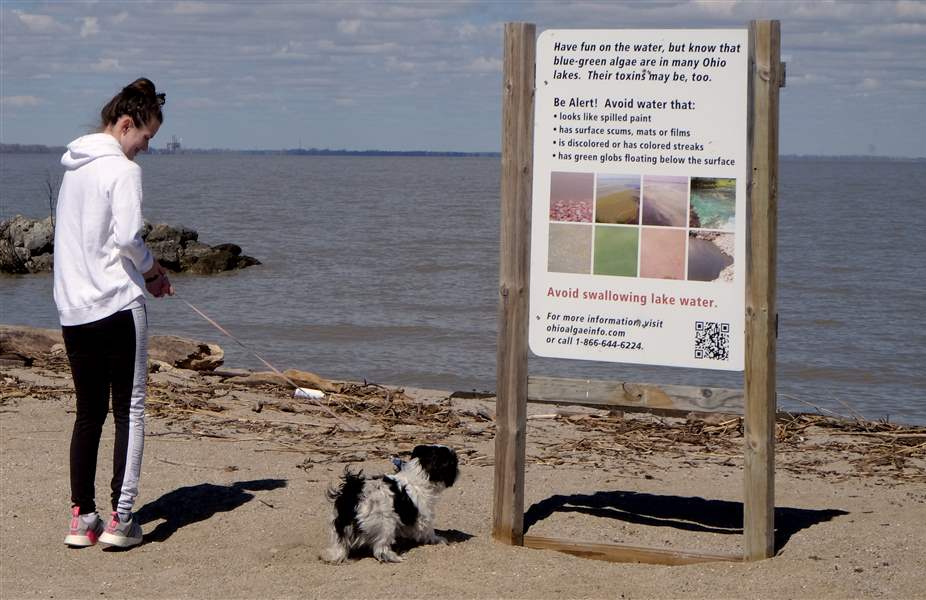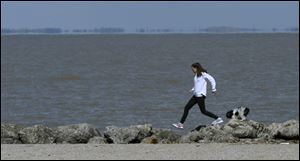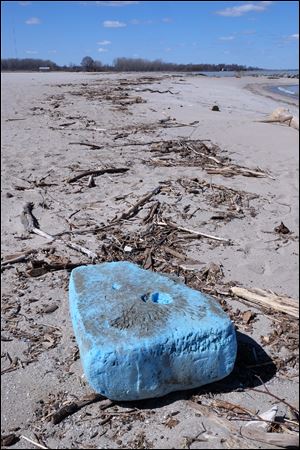
Bill aims to help Lake Erie after impairment designation
3/23/2018
Oregon resident Alison Domagala, 15, walks her dog Oreo, a Yorkie-Poodle Shih Tzu mix, along Lake Erie at Maumee Bay State Park in Oregon.
THE BLADE/LORI KING
Buy This Image
Three state agency directors are promoting a two-pronged piece of legislation that — while not written specifically for compliance with Ohio’s new impairment designation for the open waters of western Lake Erie — is expected to serve as a first step toward achieving some of the goals.
Ohio Environmental Protection Agency Director Craig Butler, Ohio Department of Agriculture Director David Daniels, and Ohio Department of Natural Resources Director Jim Zehringer said Friday they hope to have legislation introduced by state Rep. Steve Arndt (R., Port Clinton) that will do more to reduce phosphorus from sewage-treatment plants and regulate manure spreading near streams.
The three addressed the bill during a gathering at the University of Toledo’s Lake Erie Center in Oregon to discuss how to move forward in light of Lake Erie’s impairment designation.
The Ohio EPA said the bill calls for a statewide phosphorus permit limit for sewage-treatment plants that would be one part per billion or less for consistency.
Most major sewage-treatment plants in the western Lake Erie basin, including Toledo’s, already operate at that level, but the goal is to have all plants operating under the same limit, and then see if it needs to be tightened.
Toledo’s current permit expires July 31, 2019. Mr. Butler told The Blade in September that the city’s permit would be reviewed before then, regardless of the new impairment designation.
Michigan officials have implored Ohio officials to make Toledo’s sewage-discharge permit as stringent as Detroit’s. Toledo is allowed to release up to one part per billion of phosphorus in its permit, whereas Detroit’s limit has been set at 0.6 ppb.

Oregon resident Alison Domagala, 15, walks her dog Oreo, a Yorkie-Poodle Shih Tzu mix, along Lake Erie at Maumee Bay State Park in Oregon.
Although Toledo’s sewer plant discharge into the Maumee River is, in practice, roughly 0.6 ppb, the Ohio EPA might make that the limit in the city’s next five-year permit if science supports it, Mr. Butler said.
On Friday, he did not go into specifics but said changes are coming for many sewage-treatment plants. He told The Blade he agrees with scientists from Heidelberg University, Ohio State University, and other institutions who believe sewage-treatment plants put out relatively little phosphorus compared to the agricultural industry, adding those so-called “point sources” need to be kept up to date with best available technology.
“It’s gone on too long, and we need to get it done,” Mr. Butler said of the statewide review.
On a much bigger scale to environmental regulators — although seemingly government minutia to the layman — will be a proposal in the bill to expand the definition of “agricultural pollution” to include fertilizer.
That would direct the state agriculture department to establish rules for streams classified as “watersheds in distress” because of fertilizer. The definition change also will make it easier for the Ohio EPA to limit manure-spreading in those areas, Mr. Butler said.
“Words matter in those definitions,” he said. “It seems simple, but it’s a very large change.”
He said the agencies have been working on the bill for more than a year and that the legislation also proposes a stronger focus on nutrient management plans.
As for the highly contentious impairment controversy, Mr. Butler said officials in his agency will continue to look for other ways to help implement it and resolve disputes over whether excessive algae-growing nutrients constitute violations of the federal Clean Water Act, as alleged in a federal lawsuit against the U.S. EPA.
He still seemed uncertain what the impairment designation will mean in practice, but said his agency is committed to doing what is necessary to comply with it.
“While important from a regulatory perspective under the Clean Water Act, we still believe it doesn’t give us any regulatory tools to achieve with the 40 percent reduction,” Mr. Butler said, referring to the goal Ohio, Michigan, and Ontario have of achieving a 40 percent reduction in phosphorus releases into the western Lake Erie basin by 2025.

Trash along Lake Erie at Maumee Bay State Park in Oregon, Ohio.
“I’m pretty convinced, in addition to the voluntary and mandatory practices we already have in place, that this can get us on the trajectory to meet the goal of 40 percent reduction by 2025,” he said.
Dave Spangler, vice president of the Lake Erie Charter Boat Association, said he believes the impairment designation was inevitable, but agrees there needs to be more understanding about what it means going forward.
“We are very pleased by the potential of the bill,” he said. “That’s a big, big start.”
Paul Pacholski, the association president, said the biggest thing about the impairment designation might be the “momentum moving forward” it has generated.
“This is an opportunity to keep that momentum going, to get with our state representatives and keep them focused on cleaning up the lake,” he said.
Contact Tom Henry at thenry@theblade.com, 419-724-6079, or via Twitter @ecowriterohio.